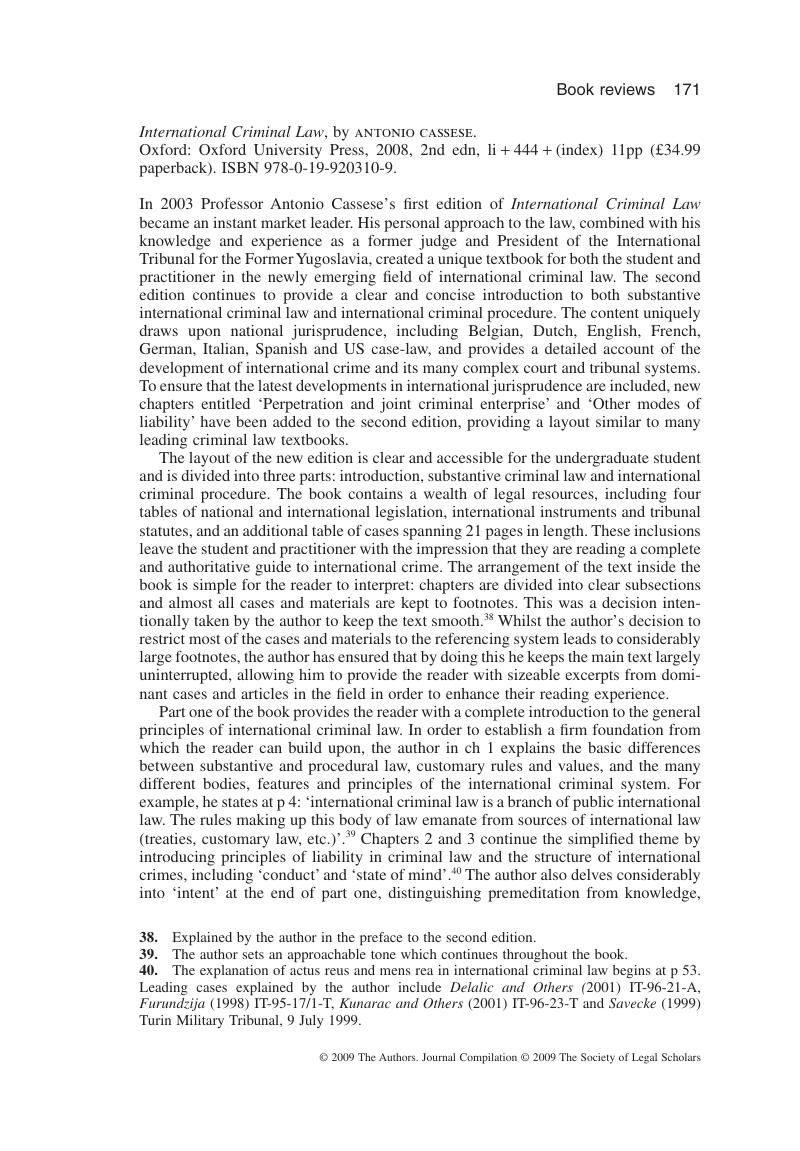No CrossRef data available.
Article contents
International Criminal Law, by Antonio Cassese. Oxford: Oxford University Press, 2008, 2nd edn, li + 444 + (index) 11pp (£34.99 paperback). ISBN 978-0-19-920310-9.
Published online by Cambridge University Press: 02 January 2018
Abstract

- Type
- Book Review
- Information
- Copyright
- Copyright © Society of Legal Scholars 2009
References
38 Explained by the author in the preface to the second edition.
39 The author sets an approachable tone which continues throughout the book.
40 The explanation of actus reus and mens rea in international criminal law begins at p 53. Leading cases explained by the author include Delalic and Others (2001) IT-96-21-A, Furundzija (1998) IT-95-17/1-T, Kunarac and Others (2001) IT-96-23-T and Savecke (1999) Turin Military Tribunal, 9 July 1999.
41 See in particular pp 66 and 70. Leading cases include Gotzfrid (1999) Stuttgart District Court, 20 May 1999, The Synagogue Case (1948) Germany Supreme Court, 10 August 1948, and Goring and Others (1947) (Nuremberg: IMT, 1947).
42 Labelled as such by the author at p 148.
43 The objective elements required depend on the class of war crime that the culpable behaviour falls into. ‘Grave breaches’ are described at p 89 as ‘serious war crimes against a protected person of war’, ie the wounded, shipwrecked persons, prisoners of war, and civilians. The author illustrates in detail that the first, second, third and fourth 1949 Geneva Conventions at Arts 50, 51, 130 and 147 outline the various war crimes. Tadic (1999) IT-94-1-A is the leading case, followed by Pilz (1959) 17 ILR 1950, Motosuke (1948) Netherlands East Indies, 28 January 1948, and Lehnigk and Schuster (1994) Court of Assize of S Maria Capua Vetere, 25 October 1994.
44 These include ‘particularly odious offences’, ‘not isolated or sporadic’, ‘widespread’, ‘in time of war or peace’, and ‘victimised civilians’, at pp 98–99.
45 Such as murder, extermination, enslavement, torture, etc. A much more detailed list is to be found at pp 109–114.
46 The ICTY held at p 503 that: ‘for the crime of extermination to be established, in addition to the general requirements for a crime against humanity, there must be evidence that a particular population was targeted and that its members were killed or otherwise subjected to conditions of life calculated to bring about the destruction of a numerically significant part of the population’.
47 Coverage of Art 7 of the ICC Statute – relating to crimes against humanity – starts at p 123 of the text, and includes a considerable analysis of the flaws of the Article. Specifically mentioned concentration-camp cases include Mulka and Others (1969) Germany Federal Court of Justice, 20 February 1969 (Auschwitz), Martin Gottfried and Others (1945) US General Military Government Court of the United States Zone, 13 December 1945 (Dachau), Gotzfrid (1999) Stuttgart District Court, 20 May 1999 (Majdanek), Kopperlmann (1950) Belgium Court of Cassation, 27 November 1950 (Belgium), Kotalla (1949) Special Court of Cassation Second Chamber, 5 December 1949 (Netherlands), and Mittermair (1945) Italy Special Court of Assize, 27 November 1945 and Mitterstieler (1945) Italy Bolzano Special Court of Assize, 11 December 1945 (Italy). In some cases the courts have held that the subjective element may be ‘culpable negligence’: see Hinselmann and Others (1947) UK Court of Appeal Control Commission in the British Zone of Control, 24 March 1947 at 58–60.
48 These include Hoess (1947) Poland Supreme National Tribunal, March 1947, Greifelt and Others (1948) United States Military Tribunal at Nuremberg, 10 March 1948, Eichmann (1961) Israel Supreme Court, 29 May 1962, 36 ILR 277, Akayesu (2000) ICTR AC 22, Kayishema and Ruzindana (2001) ICTR AC 1 June 2001, Jelisic (1999) IT-95-10-T and Krstic (2001) IT-98-33-T, and very recently Bosnia v Serbia (2007) ICJ 26 February 2007.
49 At p 133 the author begins to dismantle the objective elements of the 1951 Genocide Convention, and includes an analysis of a significant volume of international case-law. Particular attention is paid to the definition of ‘groups’ at pp 138–140.
50 This chapter is particularly complex and requires a deep understanding of the UN Charter.
51 A lot of time is given to aggression in this chapter and ‘its sudden emergence and its immediate falling into lethargy’ beginning at p 152.
52 At pp 162–165, including a discussion as to whether the international community will ever agree on a definitive definition of terrorism.
53 At p 165.
54 At p 187 the author accepts that many global jurisdictions do not make legal distinctions between participants in a crime.
55 At p 233.
56 See p 235 for examples of culpable omissions in international criminal law, including Sumida Haruzo and Others (1946) British Court for the Trial of War, Singapore, 15 April 1946, where it was shown that a breach of the duty to provide food and care for detained civilians was held to be a war crime.
57 Professor Antonio Cassese is the former President of the Council of Europe Committee for the Prevention of Torture. He gives substantial contributions to leading cases, including: Tadic (1999) IT-94-1-D, Blaskic (1997) IT-95-14-AR, Erdmovic (1997) IT-96-22-A and Furundzjia (1998) IT-95-17/1-A.
58 See pp 379, 380, 386 and 389, respectively.


